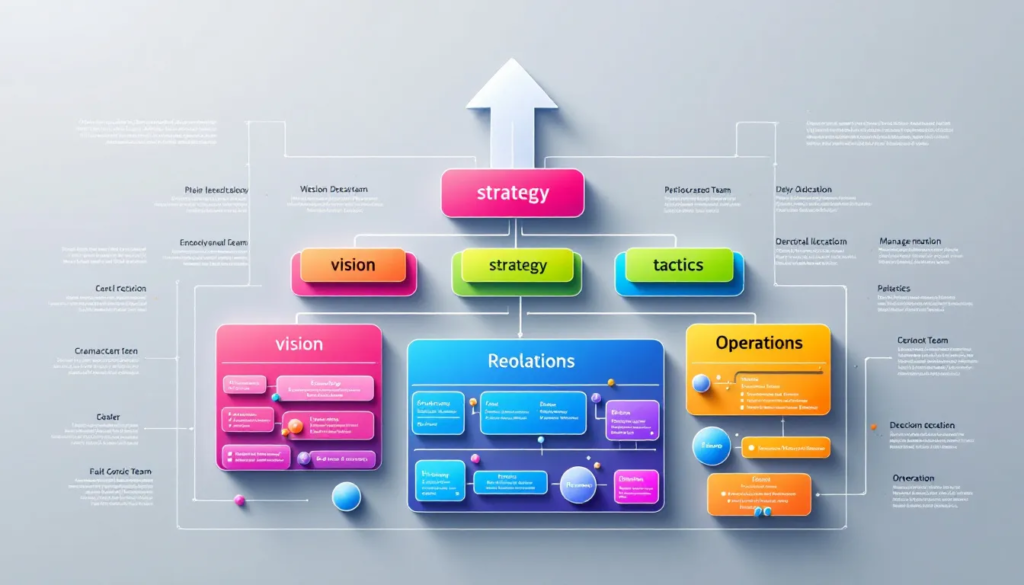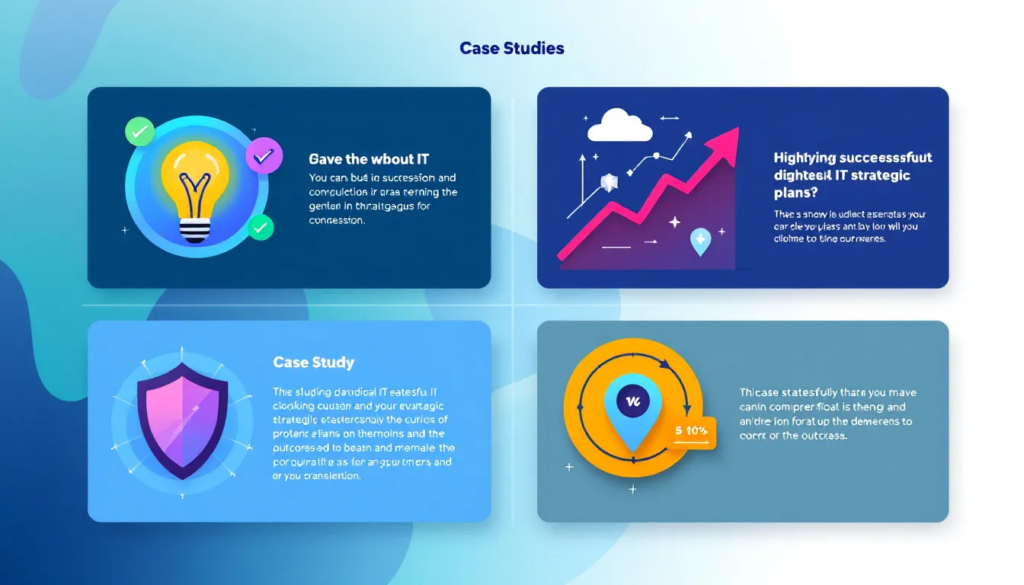How can you develop a robust IT strategy? The 5 step IT strategy framework provides a practical solution. By following these steps, you can assess your IT capabilities, identify improvements, align resources, implement governance, and continuously adapt. This guide will take you through each step to ensure your IT strategy aligns with business goals.
Key Takeaways
-
- An effective IT strategy framework is essential for aligning IT initiatives with business goals, ensuring resources are used efficiently and maximizing competitive advantage.
- Continuous assessment and adaptation of IT capabilities are crucial; using tools like SWOT analysis and stakeholder engagement helps identify improvement areas.
- Integrating best practices from industry frameworks, such as COBIT and ITIL, enhances IT strategy execution, while regular reviews facilitate responsiveness to changing business needs.
Understanding the Importance of an IT Strategy Framework

Aligning IT initiatives with business strategy through a clear IT strategy framework prevents disjointed efforts and wasted resources on unnecessary technologies and initiatives. This continuous process ensures IT remains a competitive advantage for the business.
Effective IT strategic planning starts with understanding the big picture, setting clear strategic goals, and making informed decisions that contribute to organizational growth. This approach allows teams to drive greater impact and achieve company goals, ensuring IT initiatives continue to meet evolving business needs.
A well-defined IT strategy framework outlines essential elements and their interactions, providing a roadmap for future-proofing the business and leveraging IT as a competitive advantage. Aligning IT strategy with business strategy helps avoid unnecessary costs and ensures the success of digital transformation initiatives.
Strategic planning in IT focuses on leveraging resources to achieve business objectives. This framework informs decisions, sets clear goals, and aligns teams towards a common vision, ensuring every IT initiative supports the organization’s priorities.
Step 1: Assess Current IT Capabilities and Business Objectives
Assessing current IT capabilities and business objectives is the first step in strategic planning. This assessment determines how well existing systems meet business needs and identifies gaps, laying the foundation for informed decision-making.
Evaluating the existing IT environment identifies areas needing improvement and highlights processes requiring enhancements. Engaging key stakeholders fosters collaboration and ensures diverse perspectives, providing a comprehensive view of current limitations and needs.
SWOT analysis, understanding internal strengths and weaknesses alongside external opportunities and threats, is a valuable tool in this assessment phase. Conducting a SWOT analysis gathers insights from various teams and builds a robust business case for strategic IT initiatives aligning with business priorities.
Step 2: Identify Areas for Improvement
Once current IT capabilities are clear, the next step is identifying areas for improvement by analyzing service performance data and customer feedback to uncover opportunities for enhancing processes.
ITIL’s Continual Service Improvement processes involve regular assessments of service performance data, customer feedback, and process metrics to pinpoint inefficiencies. Adopting these best practices helps organizations track progress and ensure continuous improvements.
Engaging stakeholders across the organization identifies their needs and translates them into specific, actionable goals. This step involves outlining goals and creating steps to address weaknesses, ensuring the it planning process remains focused on tangible improvements.
Step 3: Align Organizational Structure and Resources

Aligning organizational structure and resources is crucial for successful IT strategy execution. The McKinsey 7S Model identifies seven key elements critical for organizational effectiveness: Structure, Strategy, Skill, System, Shared Values, Style, and Staff, emphasizing their interconnectedness.
Assessing the current structure ensures it supports IT objectives effectively, potentially involving redefining roles, responsibilities, and reporting lines to enhance efficiency and accountability. A top-down approach in the McKinsey 7S Model aligns strategy and shared values with the organizational structure.
Identifying misalignments in values, strategy, and systems is essential for effective organizational design. Leaders should determine the ideal organizational design by researching changes required in different 7-S elements based on the long-term business vision and priorities, ensuring alignment between strategy and operations.
Step 4: Implement Governance Models and Best Practices
Governance models are crucial for successful strategy execution, requiring close collaboration between business and IT teams. Gartner’s Pace-Layered Application Strategy categorizes applications based on their rate of change into Systems of Record, Systems of Differentiation, and Systems of Innovation.
Developing and implementing policies and procedures that support the new IT strategy and organizational structure is essential. Implementing COBIT’s control objectives ensures effective IT governance and management, helping maintain consistency and alignment with business strategies.
Periodically reassessing application categorization using Gartner’s Pace-Layered Application Strategy ensures IT resources remain aligned with business goals, supporting business change and innovation while evolving governance models with the organization’s needs.
Step 5: Establish a Continuous Review and Adaptation Process
Establishing a continuous review and adaptation process is the final step in IT strategic planning. Regularly reviewing and updating the plan ensures its relevance in a rapidly changing technological landscape, incorporating updates to prevent issues from becoming critical problems.
Frequent risk assessments identify and address potential vulnerabilities in the IT strategy. Measuring and managing progress ensures alignment on objectives and allows for regular evaluation of strategy execution. A mindset of continuous improvement adapts strategic plans to changing circumstances, keeping the IT strategy dynamic and effective.
Setting up regular check-ins and evaluations to track progress and make necessary adjustments maintains the strategic plan’s success and aligns it with the organization’s evolving goals and market conditions.
Key Components of an Effective IT Strategic Plan

An effective IT strategic plan serves as a comprehensive roadmap that aligns technology initiatives with business objectives, defining the organization’s goals and outlining the actions needed to achieve them. Key initiatives should be prioritized based on their potential impact.
A detailed action plan outlines specific tasks, timelines, and responsibilities, ensuring all team members understand their roles in achieving strategic objectives. Establishing performance metrics allows organizations to track the success of their IT strategic initiatives effectively.
Identifiable IT Key Performance Indicators (KPIs) are crucial for tracking and reporting progress in the IT strategic plan. These measurable and actionable KPIs facilitate performance evaluation. Additionally, having owners for IT initiatives ensures projects are managed to completion and remain aligned with business goals.
Budget considerations and focus areas are critical components of the IT strategic plan. Detailing the resources available to achieve goals and objectives while focusing on IT aspects with the most significant impact on business strategy ensures the strategic plan addresses all necessary elements for successful execution.
Leveraging Best Practices from Industry Frameworks

Leveraging best practices from industry frameworks enhances the effectiveness of an IT strategy. Integrating COBIT with ITIL allows organizations to leverage governance and management practices effectively, ensuring IT resources are consistently aligned with business goals.
Gartner’s PACE Layered Application Strategy categorizes software applications into three types: Systems of Record, Systems of Differentiation, and Systems of Innovation. Each category requires distinct governance and management approaches, ensuring applications are managed according to their rate of change and business impact.
Agile IT methodologies enable faster iterations and responsiveness to market changes, allowing organizations to stay ahead in a competitive landscape. Incorporating these best practices streamlines business processes and achieves successful strategy execution.
Common Challenges and How to Overcome Them
IT strategic planning can face several common challenges, including misalignment on goals or deliverables, flexibility risks, and unrealistic outcomes. Effective IT strategies help mitigate risks related to technology, such as cyber threats and data breaches.
Enhancing communication and alignment involves ensuring clear and regular communication about goals and deliverables. Plans should be flexible enough to allow necessary changes and improvements, avoiding the risk of inflexibility. Setting realistic and achievable outcomes is crucial to avoid overpromising and underdelivering.
Proper training ensures employees meet new standards and effectively execute the IT strategy. Organizations should stay proactive and anticipate potential threats to handle issues effectively. Addressing these challenges head-on ensures IT strategic plans are robust and adaptable.
Case Studies of Successful IT Strategic Plans

Examining real-world examples provides valuable insights into successful IT strategic plans. One organization conducted a thorough assessment of its current IT capabilities to identify areas needing improvement, laying the groundwork for a strategic plan that aligned technology initiatives with business objectives, resulting in optimal performance.
Another organization used a governance model based on COBIT to enhance their IT management practices, leading to increased IT efficiency and improved service delivery. Integrating best practices from ITIL significantly improved service quality and customer satisfaction.
An organization that implemented continuous review processes swiftly adapted its IT strategy, driving innovation and maintaining alignment with business leaders’ goals. These case studies highlight the importance of adaptability and integrating best practices in IT strategic planning, emphasizing the need for ongoing assessments to ensure sustained alignment with business objectives and new technology.
Summary
In summary, developing and maintaining an effective IT strategy is a multi-faceted process that requires careful planning and continuous adaptation. By following the 5-Step IT Strategy Framework, organizations can align their IT initiatives with business objectives, ensuring optimal resource utilization and long-term success.
Each step, from assessing current capabilities to establishing a continuous review process, plays a critical role in the overall strategic planning process. Implementing governance models and leveraging best practices from industry frameworks further enhances the effectiveness of the IT strategy.
As technology continues to evolve, staying proactive and adaptable is essential. Embrace the journey of strategic IT planning with confidence, knowing that a well-structured approach will lead your organization to success.
Frequently Asked Questions
Why is it important to align IT strategy with business strategy?** **?
Aligning IT strategy with business strategy is crucial because it ensures that technology efforts directly support and enhance your company’s goals, maximizing efficiency and minimizing waste. This strategic alignment empowers your business to thrive in a competitive environment!
What is the role of the McKinsey 7S Model in IT strategic planning?** **?
The McKinsey 7S Model is crucial for aligning your organization’s structure and strategy with IT objectives, ensuring that all components work together effectively. Embrace this holistic approach to drive impactful IT strategic planning!
How do COBIT and ITIL frameworks complement each other?** **?
COBIT and ITIL complement each other by aligning IT resources with business goals and enhancing governance through established service management best practices. Embrace both frameworks to drive efficiency and ensure IT contributes to your organization’s success!
What are the critical components of an effective IT strategic plan?** **?
An effective IT strategic plan is essential for success and must include a detailed action plan, performance metrics, key initiatives, and budget considerations. By aligning technology initiatives with your business goals, you can ensure that every step leads you closer to achieving your vision.
How can organizations overcome common challenges in IT strategic planning?** **?
To effectively overcome challenges in IT strategic planning, organizations should emphasize clear communication, set realistic goals, and embrace flexibility in their plans. By investing in employee training and proactive risk assessment, they can navigate obstacles and drive continuous improvement.






